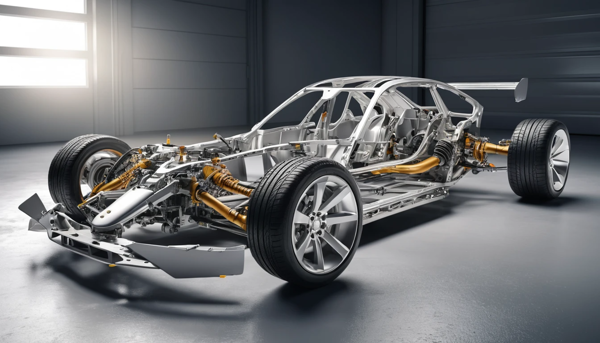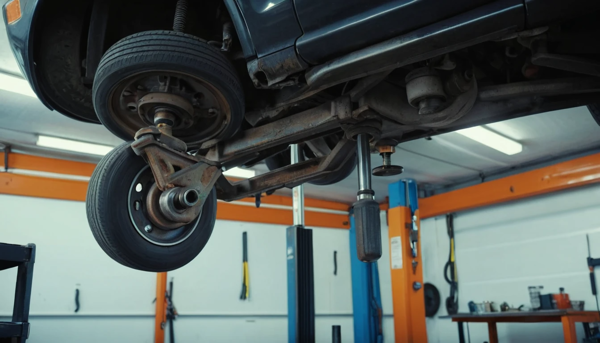What is a car’s unibody frame? Discover how it works, why it matters, and how it keeps your vehicle safe on the road.
What Is a Car’s Unibody Frame? 🚗 Let’s Break It Down!
Ever wonder what keeps your car together while driving? Is it just metal panels stuck together? Or is there something more?
Well, welcome to the world of unibody frames. They are the hidden skeleton that makes your car strong, safe, and shaped right.
Let’s explore what a unibody frame is, why it’s important, and how it’s so different from old-style body-on-frame cars. If you’re buying, fixing, or just curious, you’re in the right spot.
🚘 What Exactly Is a Unibody Frame?
A unibody frame is when the car’s body and frame are merged into one. Unlike trucks, the car’s body is the frame itself.
This design makes the car’s body strong and supportive. It’s like your body and skin working together.
In simple terms:
A unibody car uses its body panels as part of the overall support system.
Benefits of Unibody Frames:
- Better fuel efficiency
- Improved handling
- Lower weight
- Enhanced crash safety
- Smoother ride
🔧 How Does It Work? The Engineering Behind It
Unibody design combines different parts of the car into one shell. Engineers use special metals and welding to make it strong and flexible.
Here’s how it’s done:
- Steel or aluminum panels are stamped and formed.
- These panels are welded together into one shell.
- Structural reinforcements are added in key stress areas.
- The frame supports the engine, suspension, and passengers—all in one unit.
🛠️ Unibody vs. Body-On-Frame: What’s the Difference?
Let’s clear this up once and for all. These two terms get thrown around, but they’re not the same—and they each serve different types of vehicles.
| Feature | Unibody Frame | Body-On-Frame |
|---|---|---|
| Construction | Frame and body are one | Separate frame and body |
| Common in | Cars, crossovers | Trucks, SUVs, off-road vehicles |
| Ride comfort | Smoother, more refined | Rougher, stiffer ride |
| Crash safety | High—built-in crumple zones | Lower—depends on body attachment |
| Towing capacity | Lower | Higher |
| Cost & weight | Lower weight, better fuel economy | Heavier, more expensive |
💥 Why Do Most Modern Cars Use Unibody?
It makes cars lighter, safer, and more affordable.
Car makers switched to unibody designs in the 1980s. This change was for three main reasons:
- Fuel efficiency regulations
- Crash test standards
- Customer preference for smoother rides
Unibody cars also handle better on paved roads. They are great for daily driving.
🧱 Is a Unibody Car Strong Enough?
Yes, and here’s why: engineers make special parts strong. They focus on the pillars, floorpan, and side rails. This makes the car:
- Absorb collision forces
- Prevent the cabin from collapsing
- Keep weight balanced
💡 Fun fact: In some crash tests, unibody cars perform better than trucks with body-on-frame designs.
🔍 Key Components of a Unibody Frame
Let’s look at the main parts of a unibody structure:
| Component | Function |
|---|---|
| Front rails | Support engine, absorb front crash forces |
| Rocker panels | Strengthen sides and support door structure |
| A, B, C pillars | Connect the roof to the frame, prevent collapse |
| Floorpan | Base of the car—connects all lower parts |
| Rear frame rails | Support rear suspension and absorb rear impacts |
All these parts work together like puzzle pieces. They form a tough, safe shell.
🧩 What Materials Are Used in Unibody Frames?
It’s not just plain steel anymore. To reduce weight and boost safety, manufacturers use a mix of advanced materials. They include:
- High-strength steel (strong but flexible)
- Aluminum (lightweight, rust-resistant)
- Carbon fiber (in high-end models, ultra-light)
This mix gives modern unibody frames an ideal balance of rigidity and resilience.
🚧 Can You Repair a Damaged Unibody Frame?
Yes—but it depends on the damage. Unibody frames are more complex to repair than body-on-frame ones. If the frame is bent or warped, you’ll need special tools and technicians.
Typical repairs include:
- Pulling or straightening the frame
- Replacing entire panels or subframes
- Welding in new structural parts
📌 If a unibody car has major frame damage, it might be declared a total loss by insurance.
🔩 How Are Subframes Related to Unibodies?
Great question! A unibody car doesn’t have a separate main frame. But, it can use subframes for things like:
- Engine and transmission mounts
- Front and rear suspension
These subframes bolt into the main unibody. They can be removed or replaced. They help reduce vibration and make repairs easier.
🧭 How Unibody Frames Affect Handling & Performance
One big plus of a unibody car is how it drives. The tight structure means:
- Less body flex
- Quicker steering response
- Smoother cornering
- Better control at high speeds
If you like a smooth, agile ride, thank unibody engineering.
🛡️ What About Crash Safety?
Unibody frames have built-in crumple zones. These zones collapse in a controlled way during an impact. This absorbs energy and protects passengers.
Key Safety Features:
- Reinforced passenger cell 🧍♂️
- Side-impact bars
- Collapsible front and rear ends
- Airbag integration points
In short, unibody frames are engineered to protect lives, not just hold the car together.
🔋 Are Electric Cars Built on Unibody Frames?
Yes—almost all electric cars use unibody platforms. They need a rigid base to support the battery pack, which is usually on the floor.
Unibody = Perfect match for EVs ✅
It keeps the weight low, enhances safety, and gives you that smooth, quiet ride EV drivers love.
🏆 Best Cars Known for Strong Unibody Frames
| Make & Model | Why It Stands Out |
|---|---|
| Honda Accord | Lightweight yet strong frame |
| Toyota Camry | Excellent crash test ratings |
| Tesla Model 3 | EV unibody with superior rigidity |
| Subaru Outback | Reinforced unibody for off-road capability |
| Mazda CX-5 | Balanced frame for sporty handling |
These cars show how versatile and reliable unibody construction can be.
🧰 Maintenance Tips for Unibody Vehicles
Want your car’s frame to last longer? Follow these smart tips:
- Avoid hard impacts like potholes and curbs
- Keep the underbody clean to prevent rust
- Address alignment issues quickly
- Don’t ignore strange vibrations or squeaks
- Use qualified shops for body repairs
A little attention goes a long way in protecting your car’s hidden strength.
🧠 Summary: Key Takeaways About Unibody Frames
Let’s wrap it up. Here’s what you’ve learned:
- A unibody frame combines the body and frame into one piece.
- It’s lighter, safer, and more efficient than body-on-frame.
- Most modern cars and EVs use unibody construction.
- It offers better handling, safety, and fuel economy.
- Repairs can be tricky—but they’re possible with the right tools.
So next time someone asks, “What is a car’s unibody frame?”—you’ve got the perfect answer. 😎
🙋♀️ FAQs
What does a car’s unibody frame mean?
It means the frame and body are a single structure, not separate parts.
Is unibody safer than body-on-frame cars?
Yes, unibody designs usually offer better crash protection and crumple zones.
Can a unibody car be used for towing?
Yes, but it’s better for light-duty towing—trucks handle heavier loads.
How do I know if my car has a unibody?
Check the owner’s manual or look under the car—if there’s no big steel frame, it’s unibody.
Are unibody cars good for off-roading?
Not usually. Body-on-frame vehicles handle rough terrain better.
🔗 References
https://www.caranddriver.com/features/a15132455/body-on-frame-vs-unibody/
https://www.motortrend.com/features/what-is-unibody-construction/
https://www.autoblog.com/article/unibody-vs-body-on-frame/







Leave a Reply